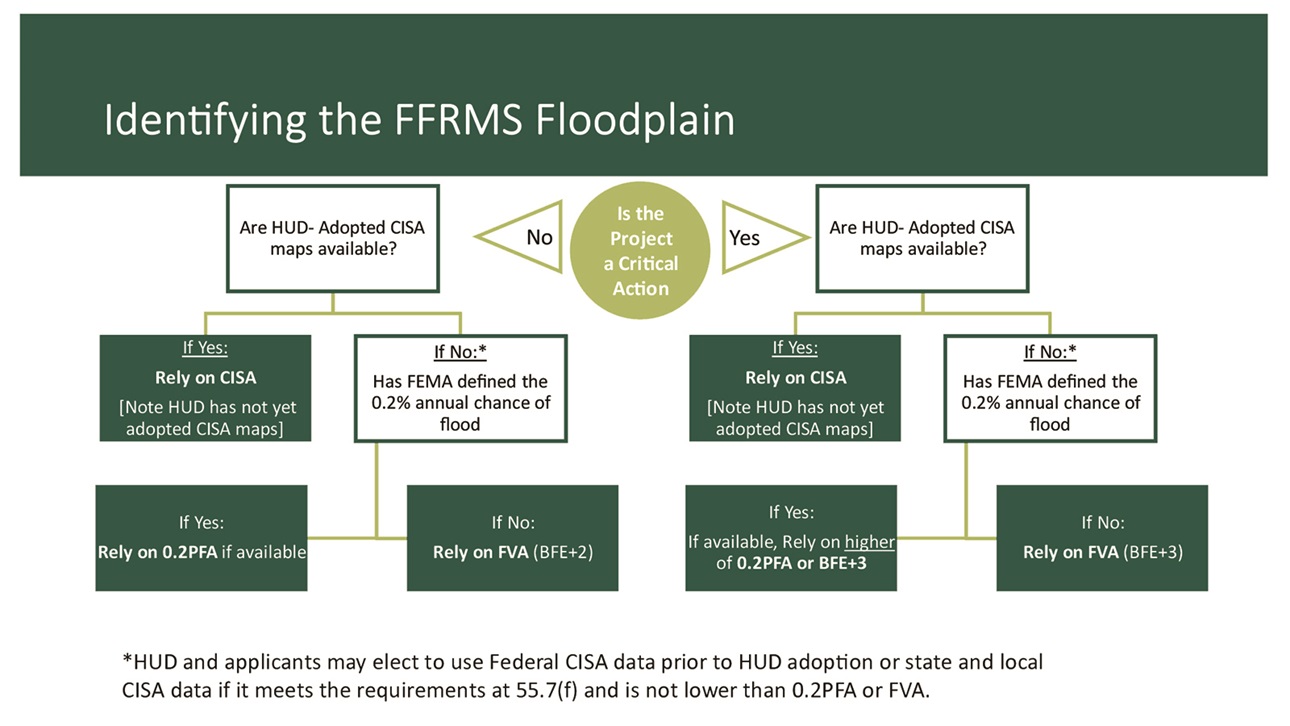What to Know About the New Federal Flood Risk Management System
The Department of Housing and Urban Development released a new Federal Flood Risk Management Standard (FFRMS) in April 2024 that will affect both single-family homes and multifamily properties. Compliance will be required as of Jan. 1, 2025.
For FHA-insured or HUD-assisted multifamily properties, the new FFRMS requires a complicated, three-tiered process for determining the extent of the FFRMS floodplain, with a preference for a climate-informed science approach (CISA). The FFRMS expands the vertical and horizontal floodplain boundaries beyond the special flood hazard area (100-year floodplains). The rule requires more stringent elevation and flood proofing requirements of properties where federal funds are used to develop or provide financing for new construction within the now defined FFRMS floodplain. It also applies to substantial improvement to structures financed through HUD grants, subsidy programs and applicable multifamily programs.

Key points of interest for single-family builders and developers:
- Compliance with new elevation requirements will be required for single-family new construction where building permit applications are submitted on or after Jan. 1, 2025.
- HUD will require single-family homes located in a 100-year floodplain to be elevated 2 feet above base flood elevation to qualify for FHA mortgage insurance.
- The final rule also includes expanded notification requirements for owners, buyers and developers.
Key points of interest for multifamily builders and developers:
- Compliance with the procedures for the FFRMS floodplain management and protection of wetlands is required for FHA-insured and HUD-assisted apartment properties no later than Jan. 1, 2025.
- For HUD-assisted, HUD-acquired and HUD-insured rental properties, new and renewal leases are required to include acknowledgements signed by residents indicating that they have been advised that the property is in a floodplain and flood insurance is available for their personal property, among other information.
- HUD assured borrowers that FHA multifamily mortgage insurance applications submitted Oct. 1, 2024, could be processed under the floodplain regulations that preceded HUD’s FFRMS requirements.
NAHB will continue to monitor this requirement and provide any updates on nahb.org.
Latest from NAHBNow
Dec 12, 2025
Preventing Cold, Flu and COVID Illnesses on Jobsites Starts with a PlanIn the construction industry, working outdoors may appear to create less risk for catching a cold, flu, and COVID-19, but it’s crucial to understand that these illnesses can still spread while working in close proximity in any conditions.
Dec 11, 2025
FHA Announces Forward Mortgage Loan Limits for 2026The Federal Housing Administration (FHA) today announced its 2026 Nationwide Forward Mortgage Loan Limits, which provides the maximum mortgage loan limits for single-family homes that are insured by the FHA.
Latest Economic News
Dec 11, 2025
Homeownership Rate Inches Up to 65.3%The latest homeownership rate rose to 65.3% in the third quarter of 2025, according to the Census’s Housing Vacancy Survey (HVS).
Dec 10, 2025
No Risk-Free Path: Fed Eases Monetary PolicyThe central bank’s Federal Open Market Committee (FOMC) cut rates a third and final time in 2025, reducing the target range for the federal funds rate by 25 basis points to a 3.5% to 3.75% range. This reduction will help reduce financing costs of builder and developer loans.
Dec 09, 2025
Construction Labor Market StableThe count of open, unfilled positions in the construction industry was relatively unchanged in October, per the Bureau of Labor Statistics Job Openings and Labor Turnover Survey (JOLTS). The current level of open jobs is down measurably from two years ago due to declines in construction activity, particularly in housing.
